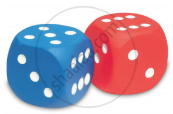Advertisements
Advertisements
Question
Two dice are rolled, find the probability that the sum is equal to 4

Solution
Sample space (S) = {(1, 1) (1, 2) (1, 3) (1, 4) (1, 5) (1, 6) (2, 1) (2, 2) (2, 3) (2, 4) (2, 5) (2, 6) (3, 1) (3, 2) (3, 3) (3, 4) (3, 5) (3, 6) (4, 1) (4, 2) (4, 3) (4, 4) (4, 5) (4, 6) (5, 1) (5, 2) (5, 3) (5, 4) (5, 5) (5, 6) (6, 1) (6, 2) (6, 3) (6, 4) (6, 5) (6, 6)}
n(S) = 36
Let E2 be the event of getting the sum is equal to 4
E2 = {(1, 3) (2, 2) (3, 1)}
n(E2) = 3
p(E2) = `("n"("E"_2))/("n"("S"))`
= `3/36`
= `1/12`
APPEARS IN
RELATED QUESTIONS
A box consists of 100 shirts of which 88 are good, 8 have minor defects and 4 have major defects. Ramesh, a shopkeeper will buy only those shirts which are good but 'Kewal' another shopkeeper will not buy shirts with major defects. A shirt is taken out of the box at random. What is the probability that
(i) Ramesh will buy the selected shirt?
(ii) 'Kewal' will buy the selected shirt?
A bag contains 3 red balls and 5 black balls. A ball is draw at random from the bag. What is the probability that the ball drawn is not red?
Suppose you drop a tie at random on the rectangular region shown in the given figure. What is the probability that it will land inside the circle with diameter 1 m?

A card is accidently dropped from a pack of 52 playing cards. The probability that it is an ace is
From the letters of the word ''MOBILE", a letter is selected. The probability that the letter is a vowel, is
In a single throw of a pair of dice, the probability of getting the sum a perfect square is
In a family of 3 children, the probability of having at least one boy is
The probability of selecting a red ball at random from the jar that contains only red, blue and orange balls is `1/4`. The probability of selecting a blue ball at random from the same jar is `1/3`. If the jar contains 10 orange balls, find the total number of balls in the jar.
From 10 identical cards, numbered 1, 2, 3, ……, 10, one card is drawn at random. Find the probability that the number on the card drawn is a multiple of
2 and 3
A dice is rolled once. What is the probability that the number on top will be odd
